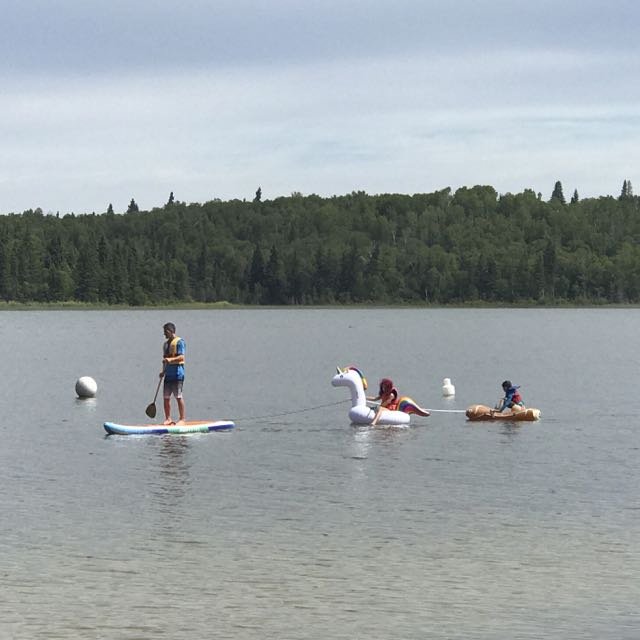
I was sitting at the beach with my journal recently, while on a private writing retreat with a friend. It was a perfect summer morning, with the kind of blue sky painted with white clouds that makes the world seem a little easier to navigate.
I was alone on the beach until a curious flotilla entered the scene from further down the shore. A man on a paddle board was pulling behind him two children – a young girl with purple hair on a floating unicorn, and, behind that, a younger boy on what looked like a plastic replica of Tom Sawyer’s raft. Despite his passengers, the man paddled and navigated with ease on the smooth lake and the entire flotilla soon landed on the shore where I sat.
As they approached the beach, I heard one of the children ask whether they could go further out from shore. “No,” said the man, who was clearly their father. “If we’re too far from the shore, we might get caught by the wind and drift all the way to the other side of the lake. Then we’d have to walk a few miles home.”
Climbing off their flotation devices, the children clamoured onto the beach for some play time. They explored the beach and the young boy tried to entice his sister to build a sand castle. “No,” she said, “not right now.” Instead, she followed her dad to where he’d discovered animal prints in the sand. “Deer,” she said, when he asked what she thought they were.
Before long, the dad asked if they were ready to go out again. “Yes,” they both said. “But can we go out a little deeper first so that it’s easier to climb on?” asked the girl. Her dad obliged.
On the way out, the boy asked if they could go close enough to touch one of the buoys that marked the edge of the swimming area. “It’s not easy to steer,” said the dad, “but I’ll try.” He was successful and the children both touched the buoy.
They disappeared down the beach, but a little while later, they were back within my view. This time, Dad was taking a rest from the paddling and was sitting on his paddleboard. Both children had joined him on the board, and they were trusting the gentle waves to do the work of bringing them back to shore. Soon, though, the girl was ready to climb back onto her unicorn and the boy followed suit, back onto his own raft. Dad stood up to paddle again and reminded them that they’d have to stay close to shore so that they’d be safe.
When a motorboat whizzed past and the wake rocked their flotilla, the girl said “boats are evil.” Sure enough, she was knocked off her unicorn into the water. She was wearing a life jacket, though, so she wasn’t in real danger. A man on a canoe close by called out, asking if everyone was okay. All three respond that yes, they were fine, but they appreciated the offer of support. Dad on his paddle board didn’t seem phased by his daughter capsizing – instead he watched as the young boy helped his sister climb onto his raft. They sat together for awhile, until the girl was ready to return to her unicorn
As I was watching this unfold in front of me, I became amused at the metaphor and started recording the scene in my journal. Here’s what it taught me about leadership and holding space:
- Know the limitationsof your team/community/family and avoid leading them into deeper water than you can navigate.
- If you remain under the right conditions, leadership and navigation can be smooth and easy.
- Don’t stay in the shallow waterall of the time, though, or you’ll miss some of the fun and discovery and opportunity to learn (ie. being tipped by a passing boat). Take a calculated chance now and then, and know when it’s time to return to safety.
- Invite input about direction changefrom community members (ie. touching the buoy), be honest about your capacity to give them what they ask for, and then do your best to follow through.
- Allow each member of the community/team/family/etc. to maintain their own sovereignty and identity(ie. purple hair) and to function within the container that fits them (ie. unicorn or raft). Being tied together with a common purpose doesn’t mean you have to assimilate to a certain arbitrary norm.
- Provide proper equipment and resources(ie. life jackets and rafts) so that when the water gets unexpectedly rough, community members can rescue themselves and do not need to call in outside help (or the leader) to solve the problem for them.
- Allow the community/team/family to support each other, to problem solve for each other and themselves, and to care for each other in times of stress. A leader holds space for this to happen, but doesn’t need to take it all on.
- Once in awhile, invite everyone onto the same flotation device, take a rest, and enjoy the companionship.
- Build a consent-based culture, where people can say no to building sand castles if they don’t want to, without fearing repercussions for their “no”.
- Be open to outside help(ie. a man on a canoe), but let your people feel empowered to figure things out on their own if they don’t need help.
- When you get scared(or wet from capsizing), there’s no shame in sitting in someone else’s container for awhile and letting them care for you.
- Ask for what you need(ie. slightly deeper water for ease of entry) and do your best to meet each other’s needs.
- Don’t forget to have fun!
